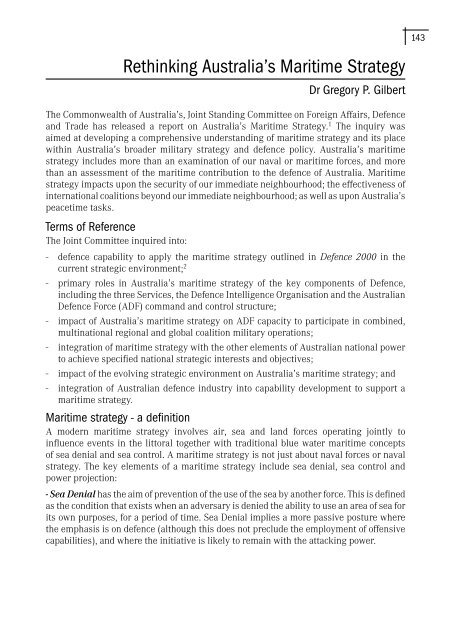Australian Maritime Issues 2005 - Royal Australian Navy
Australian Maritime Issues 2005 - Royal Australian Navy
Australian Maritime Issues 2005 - Royal Australian Navy
Create successful ePaper yourself
Turn your PDF publications into a flip-book with our unique Google optimized e-Paper software.
143<br />
Rethinking Australia’s <strong>Maritime</strong> Strategy<br />
Dr Gregory P. Gilbert<br />
The Commonwealth of Australia’s, Joint Standing Committee on Foreign Affairs, Defence<br />
and Trade has released a report on Australia’s <strong>Maritime</strong> Strategy. 1 The inquiry was<br />
aimed at developing a comprehensive understanding of maritime strategy and its place<br />
within Australia’s broader military strategy and defence policy. Australia’s maritime<br />
strategy includes more than an examination of our naval or maritime forces, and more<br />
than an assessment of the maritime contribution to the defence of Australia. <strong>Maritime</strong><br />
strategy impacts upon the security of our immediate neighbourhood; the effectiveness of<br />
international coalitions beyond our immediate neighbourhood; as well as upon Australia’s<br />
peacetime tasks.<br />
Terms of Reference<br />
The Joint Committee inquired into:<br />
- defence capability to apply the maritime strategy outlined in Defence 2000 in the<br />
current strategic environment; 2<br />
- primary roles in Australia’s maritime strategy of the key components of Defence,<br />
including the three Services, the Defence Intelligence Organisation and the <strong>Australian</strong><br />
Defence Force (ADF) command and control structure;<br />
- impact of Australia’s maritime strategy on ADF capacity to participate in combined,<br />
multinational regional and global coalition military operations;<br />
- integration of maritime strategy with the other elements of <strong>Australian</strong> national power<br />
to achieve specified national strategic interests and objectives;<br />
- impact of the evolving strategic environment on Australia’s maritime strategy; and<br />
- integration of <strong>Australian</strong> defence industry into capability development to support a<br />
maritime strategy.<br />
<strong>Maritime</strong> strategy - a definition<br />
A modern maritime strategy involves air, sea and land forces operating jointly to<br />
influence events in the littoral together with traditional blue water maritime concepts<br />
of sea denial and sea control. A maritime strategy is not just about naval forces or naval<br />
strategy. The key elements of a maritime strategy include sea denial, sea control and<br />
power projection:<br />
- Sea Denial has the aim of prevention of the use of the sea by another force. This is defined<br />
as the condition that exists when an adversary is denied the ability to use an area of sea for<br />
its own purposes, for a period of time. Sea Denial implies a more passive posture where<br />
the emphasis is on defence (although this does not preclude the employment of offensive<br />
capabilities), and where the initiative is likely to remain with the attacking power.

















